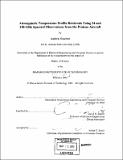| dc.contributor.advisor | David H. Staelin. | en_US |
| dc.contributor.author | Sanchez, Andrew, 1976- | en_US |
| dc.contributor.other | Massachusetts Institute of Technology. Dept. of Mechanical Engineering. | en_US |
| dc.date.accessioned | 2005-09-06T21:28:55Z | |
| dc.date.available | 2005-09-06T21:28:55Z | |
| dc.date.copyright | 2002 | en_US |
| dc.date.issued | 2004 | en_US |
| dc.identifier.uri | http://hdl.handle.net/1721.1/27049 | |
| dc.description | Thesis (S.M.)--Massachusetts Institute of Technology, Dept. of Mechanical Engineering, June 2004. | en_US |
| dc.description | Includes bibliographical references (p. 154-155). | en_US |
| dc.description.abstract | Temperature profile retrievals based on passive microwave spectral observations from an aircraft were made with a Linear Least Squares Estimator (LLSE). The National Polar-orbiting Observational Environmental Satellite System (NPOESS) Aircraft Satellite Testbed-Microwave (NAST-M) is an imaging passive spectrometer observing oxygen absorption bands at 50-57 GHz and 118.75 [plus-minus] 0.8 - 118.75 [plus-minus] 3.5 GHz. NAST-M can accurately measure brightness temperatures aboard Scaled Composite's Proteus Aircraft from an altitude of 16 km. Simulating the brightness temperatures NAST-M would observe required the use of the TIGR profile set of 1761 radiosondes from around the world. Using the entire set of simulated data, the RMS retrieval error averaged <2K for pressure levels from the surface to the aircraft. Data collected for retrievals were measured during CLOUDIOP, WVIOP, and AFWEX deployments over the Southern Great Plains. The flights occurred during March 2000, October 2000, and December 2000 respectively. Six flights have been studied for naturally occurring phenomenon. Using radiosondes collected from the Atmospheric Radiation Measurement (ARM) Program, a gain and baseline calibration correction was implemented to improve the accuracy of temperature profile retrievals for a particular day. Sensitivity of the NAST-M data was approximately [plus-minus] 0.5K and [plus-minus]0.8K for 54 and 118-GHz spectrometers respectively, with the exception of channel 1 for both systems. Additive RMS noise due to calibration drift, interference, or unknown causes was calculated to be -0.1K and -0.5K respectively. | en_US |
| dc.description.statementofresponsibility | by Andrew Sanchez. | en_US |
| dc.format.extent | 155 p. | en_US |
| dc.format.extent | 7578343 bytes | |
| dc.format.extent | 7598586 bytes | |
| dc.format.mimetype | application/pdf | |
| dc.format.mimetype | application/pdf | |
| dc.language.iso | en_US | |
| dc.publisher | Massachusetts Institute of Technology | en_US |
| dc.rights | M.I.T. theses are protected by copyright. They may be viewed from this source for any purpose, but reproduction or distribution in any format is prohibited without written permission. See provided URL for inquiries about permission. | en_US |
| dc.rights.uri | http://dspace.mit.edu/handle/1721.1/7582 | |
| dc.subject | Mechanical Engineering. | en_US |
| dc.title | Atmospheric temperature profile retrievals using 54 and 118-GHz spectral observations from the Proteus Aircraft | en_US |
| dc.type | Thesis | en_US |
| dc.description.degree | S.M. | en_US |
| dc.contributor.department | Massachusetts Institute of Technology. Department of Mechanical Engineering | |
| dc.identifier.oclc | 56795520 | en_US |
